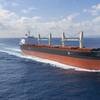On 10 February 2016, the Baltic Dry Index (BDI) hit 290. At that point, a bulk carrier regardless of its size, age and fuel-efficient qualities earned a time charter average of USD 2,417-2,776 per day.
Whereas the three smaller segments have seen higher earnings since then, capesize earnings lost ground up until the end of March. By mid-April, the gap closed and capesizes are back on par with the pack. Despite the fact that earnings have doubled in those two months, they remain below OPEX levels for the largest part of the fleet.
Despite the many attempts by steel mills around the world to fend off Chinese steel from their home market, China’s steel export volumes did not fall significantly in January and February.
Export dropped by just 1.6% to 17.85 million tonnes. New data for March showed exports of 10 million tonnes. In 2015, China flooded the world market as 112 million tons were exported, bringing down scrap steel prices in the wake of it.
Global crude steel production for January and February combined was 5.6% lower than in the same period of 2015, according to Worldsteel. Crude steel production in China was down 6.5% at the same time.
The three key items to watch out for in 2016 are Chinese imports of coal and iron ore, as well as how much dry bulk tonnage is going to be demolished. Nothing else really matters to an extent that can either improve or damage the fundamentals of the dry bulk shipping market.
For the coming months: April-July, BIMCO expects transported volumes to grow slowly - as they seasonally do - from the first quarter into the second. This ought to underpin the freight market.
Notably, we expect a new record volume of combined grain and soybean exports this year from Argentina and Brazil. We do not anticipate a massive rise in freight rates for handysize, supramax and panamaxes on the back of this, as ships are already waiting around the main loading areas. Nevertheless, it should give a boost in confidence, a confidence that Moore Stephens in March assessed to be at a record low.
Another positive indication of China not being as vulnerable as some may believe, which is supporting the soft landing trajectory, is the improving domestic steel prices, seen since mid-February.
In the international markets, spot iron ore prices have also rebounded from USD 41 per MT at the beginning of 2016 to see USD 56 per MT in mid-April. Very different from the peaks of the past, but a positive indicator in the midst of all this surrounding uncertainty.
We are still worried about the sustainability of freight rates in the years to come. Our main worry is that demolition activity will slow down as the BDI improves.
If shipowners slow demolition of ships considerably, the fleet will keep growing. This will widen the fundamental imbalance further because we forecast the demand side to grow slowly in the coming years.
In order to reverse several years of adding capacity in excess of demand growth, we need to develop a multi-year trend of negative fleet growth. BIMCO assess the current utilisation rate of the dry bulk fleet at the low end of the 70s.
Looking further ahead, coal imports into India may change. If the retained political vision of making India self-sufficient in thermal coal becomes reality. Surely the jury is still out on that.
In November 2013 the then Indian Power Minister Goyal was “very confident”, when saying India may stop thermal coal imports in two to three years, as domestic production would increase. Mr. Goyal, now being India’s Energy Minister repeated the exactly the same words in April 2016. “We want to completely stop its import over the next two to three years”.
India imported 171 million tonnes of thermal coal in 2015, slightly down from 176 million tonnes in 2014. SSY expects India to import 170 million tonnes of thermal coal in 2016.










